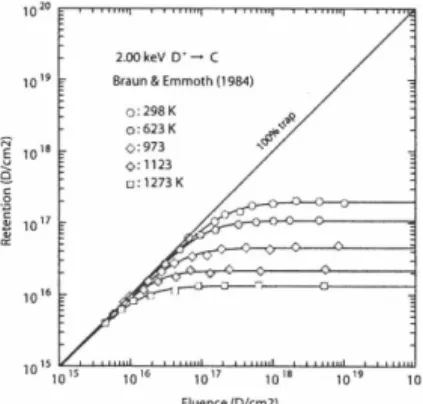§11. Data Compilation of Deuterium Retention in Plasma-Facing-Materials
Yamamura, Y., Muramoto, T. (Okayama Univ. Sci.), Hirooka, Y.,
Iwakiri, H. (RIAM, Kyushu Univ.),
Matsuhiro, K . (Faculty of Eng., Osaka Univ.)
The hydrogen retention and recycling properties of the first wall materials are important factors controlling the particle balance and the isotope composition of the plasma.
A lot of experimental data of deuterium retention in various materials have been published [1-6]. The typical experimental retention curves have two asymptotes. In the limit of the low fluence the reemission takes place only by the kinetic process, i.e., the particle reflection. In the limit of high fluence the retained amount of the deuterium atom will reach a certain saturated yield. Then we propose the following fitting formula for the experimental retention curves:
Ax y = (B lIC + x llc )c
where y is the retention yield (atom/cm 2 ), and x is the fluence (atom/cm 2 ). The parameters A, Band C are the fitting parameters. The parameters A and B correspond to the saturated retention yield and the node of two asymptotes.
From the physical point of view y = (l -R) x should be satisfied in the limit of x = 0, where R is the reflection coefficient and so AlB is equal to (1-R). In this work R is determined by using the Monte Carlo simulation code, ACAT [7].
Fig . 1 shows the retention curves in graphite at room temperature [1], where 2 keY, 5 keY, 10 keY and 20 keY deuterium ions are bombarded. Fig. 2 shows the retention curves in graphite at different temperatures, where the incident deuterium energy is 2 keY [1]. In both Fig.l and 2 the solid lines correspond to the best-fit empirical formula, and symbols mean the experimental data. The best-fit values
372
of A and C for various bombarding conditions and many ion-solid combinations are published [8]. The saturated retention yield, A, is usually proportional to the incident energy or the projected range. As the temperature increases, the molecular recombination rate and the thermal detrapping from the trap site are enhanced and so the saturated deuterium retention amount in graphite decreases exponentially as a function of temperature.
~
10"~ .~
j 10"
D'~
C 300K Braun & Emmoth (1984)
0: 20 keY 0:
10 keV
0:5
keV 0:2keV
10'6 10" 10'8 10'9 10
20Fluence (Dlcm2)
Fig. 1 Comparison of the experimental retention curves in graphite with the present empirical formula for various energies.
10
'9~ 10"
~ c:
." o
j 10
1710 '6
2.ookeV
D'~C Braun & Emmoth (1984)
0: 298 K 0:
623 K
0:973
0: 1123
0:1273 K
10 '6 10" 10'8 10'9 10
20Fluence (D/cm2)
